Gameism is a modern, practical philosophy derived from a tiny computation.
Computer science is modernizing every facet of society — finance, transport, healthcare. Gameism applies the same first-principles thinking to the world's oldest problem: what is the meaning of life, and how should I live it?



Relative
Space & Time
I'll begin by logically dismantling space and time.
In my 3-Step Proof, I demonstrate that the observer 👁️ and the observed 🏠 are the same thing.
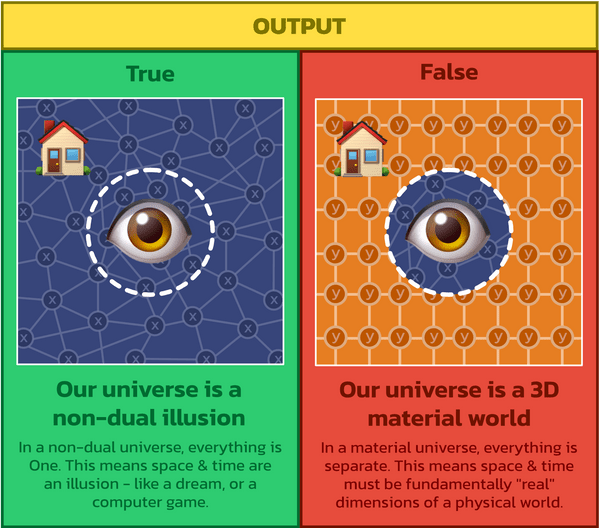
You know with 100% certainty that your consciousness (x) exists. The world outside of you could also be x, or it could be a separate, redundant entity (y) — an entity that you have no evidence for. Hence, if you believe in y, you do it on blind faith. And blind faith is not science — it's religion.
This means we live in a non-dual universe where everything outside of you is you.
But you cannot observe yourself unless you create the illusion of separation — here and there, before and after.
And since you can observe here and there, before and after...
...you can deduce that these extra dimensions of space and time are not fundamentally real — they are emerging from a lower dimension, just like they do in a computer game.
You are living in a virtual world — a relative information structure.
I'll show you what I mean...
Let's start with this question: What is space?
Imagine a computer game. A white grid fills the entire screen. My character (the observer 👁️) is a red dot. The game always keeps this dot in the center of the screen.
As I play the game, I press the arrow keys to move the dot around: ⬅️, ➡️, ⬆️, ⬇️.
I experience this after pressing the keys...
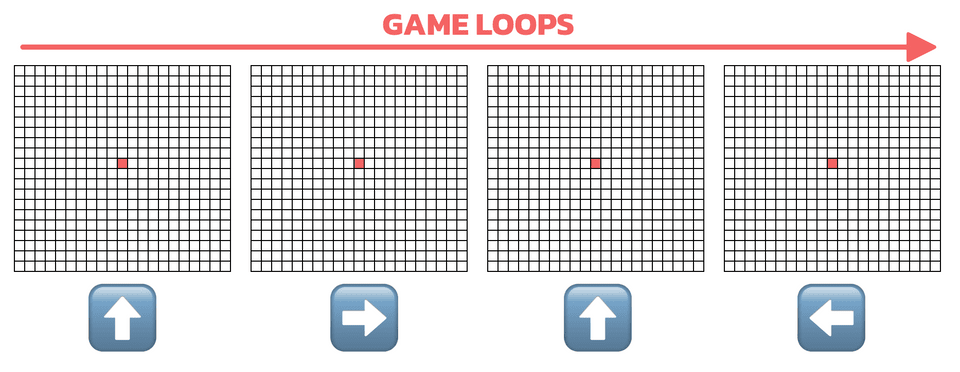
I observe the game's first frame, then press the ⬆️ key. I observe the game's second frame, then press the ➡️ key, etc.
So, did my dot move through space?
The answer is "no."
It's not that my dot didn't move through space. It's that space doesn't even exist in the game yet.
To create the illusion of space, the dot needs to move relative to something else. Otherwise, every frame of the game will be identical.
So let's add a blue dot to our game...
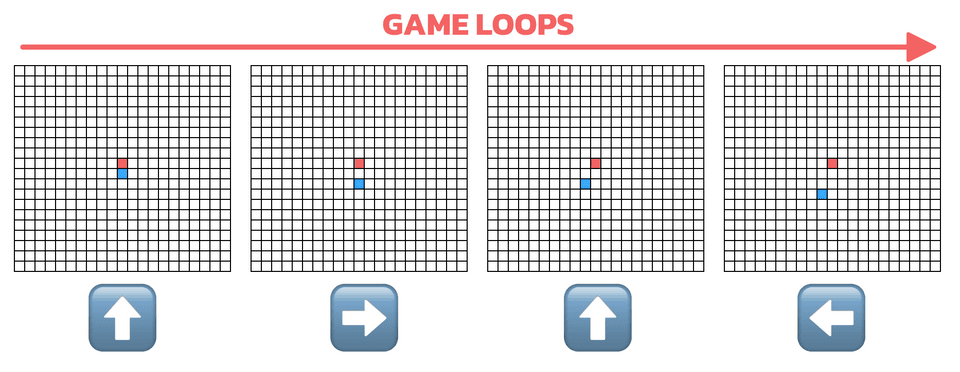
The red dot remains in the center of the screen, but now it's moving relative to the blue dot. Space now exists in the game.
Notice this: the red dot hasn't changed. It hasn't fundamentally "moved" anywhere. It's just in a different position relative to the blue dot.
But if I want to communicate this idea of "space" to someone else, I need to create a symbolic language to do that. So I might arbitrarily invent the symbol 1 meter to represent the idea of 3 pixels of "space."
Now I can say, "The red dot is 1 meter away from the blue dot in one direction, and 0.33 meters away in a different direction."
But which direction are we talking about? I need to add two more points to our information structure to create direction...
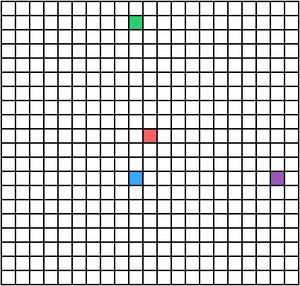
I just added a green and purple dot to our matrix.
Now I can say, "The red dot is 1 meter away from the blue dot in the green dot's direction, and 0.33 meters away in the purple dot's direction."
So, as you can see, when we talk about space, we're not actually talking about a physical "thing." We're just describing the matrix-like relationship between information using symbols like "meter," "inch," "mile," "North," "East," "left," "right," "up," "down."
At this point, you might be thinking "Okay, that's a nice, abstract idea — a fun premise for Christopher Nolan to explore in his next mind-bending sci-fi film. But even if logic suggests I'm living in a virtual world, I'm not actually living in a virtual world. Scientists have no cold, hard evidence for that."
To which I would reply, "Really? No cold, hard evidence? I mean, there's the 'weirdness' of quantum mechanics — which is not 'weird' at all... it's exactly what you'd expect in a virtual world."
Take quantum entanglement, for example.
Imagine you have two magical dice that always add up to 7. If you throw one die and get a 4, you instantly know the other die is a 3. If you throw one die and get a 2, you instantly know the other die is a 5.

The magical dice always add up to seven.
Now let's place one die on Earth and the other die on the opposite side of the universe.
The moment you observe the first die, you instantly know the state of the second die — even though the dice are separated by gazillions of light years of 3D "space."
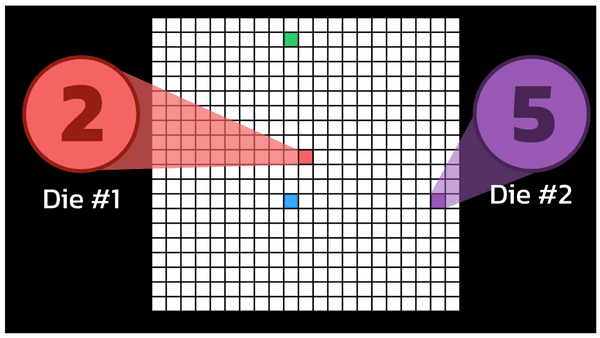
The magical dice are separated by gazillions of light years of 3D "space," yet they always add up to seven.
This is what entangled particles do. If you know the state of one particle, you instantly know the state of its complementary twin — even if that particle is on the opposite side of the universe.
If you view this phenomena — known as "nonlocality" — through the lens of materialism, the particles appear to communicate instantaneously with each other. Einstein called this "spooky action at a distance" because it implies that information can travel through three-dimensional space faster than the speed of light — and that's supposed to be impossible.
Yet, entanglement is perfectly plausible in a virtual world. Three-dimensional space doesn't fundamentally exist in the lower-dimensional codebase where everything is the same one thing.

There is no space or time in the lower-dimensional codebase.
Here's a video of me demoing quantum entanglement within the popular computer game, Minecraft. When I make an observation, the particles (glass blocks) simultaneously decide on a state (color) and update themselves in the same game loop (in the same increment of time).
NOTE: I used to run an online coding school for 8-12 year old children, teaching them how to mod their favorite computer game — Minecraft. I filmed these experiments three years ago on that platform.
Quantum mechanics may be quirky and cool. But in my opinion, the most damning evidence for non-dualism has been staring the scientific community in the face since 1905: Einstein's theory of relativity.
You see, a century ago, Einstein figured out that space and time are not independent variables — they are linked together on a continuum called spacetime.
According to Einstein’s special theory of relativity, the faster you move through space, the slower you move through time.
This makes no sense in a 3D, material world. But in a non-dual virtual world, relativity is caused by computational parsimony. It's exactly what you'd expect.
Think about it...
In a computer game, the faster you move through space, the higher your frame rate needs to be to construct the emergent illusion of space.
If you’re a snail, you’re moving so slowly through space that you could observe the game at, say, 3 frames per second and still have a perfectly smooth experience of space.
A snail moves slowly through the information structure.
But if you’re a cheetah running through the game, you're moving much faster through space...
A cheetah moves quickly through the information structure.
...so if you were to observe the game at 3 fps, your reality would glitch. You would suddenly be at point A, then point B, then point C, with no continuity between each frame of information.
Moving quickly through the information structure on a slow frame rate will dissolve the emergent illusion of space.
Therefore, a cheetah needs to observe the game at a much higher frame rate than a snail in order to construct the emergent illusion of space.
So if you were the designer of this game, you might place all observers on the highest frame rate possible. If the fastest observer needs a frame rate of 300 fps, you'd place all observers on that frame rate.
This would give every observer the same experience of space and time.
But if a snail only needs a frame rate of 3 fps, and you give it a frame rate of 300 fps, you’ve just created a computationally inefficient game.
And since the universe abides by the Principle of Least Action...
...we can deduce that it would place all observers on the minimum frame rate possible. The frame rate would actually fluctuate depending on how fast the observer is moving through space, and where they are located in space, relative to other observers.
This option is perfectly parsimonious and computationally efficient, but it produces a quirky side-effect. Variable frame rates inextricably link space and time together — thus giving us relativity and its weird consequences, like time dilation.
For example, let's pretend the cheetah agrees to meet the snail in the next five minutes — but the snail is observing the game at 3 fps while the cheetah is observing the game at 300 fps. The cheetah runs to the snail and shows up five minutes later from her perspective. But because her frame rate is higher than the snail's, 8 hours and 20 minutes have gone by from the snail's perspective.
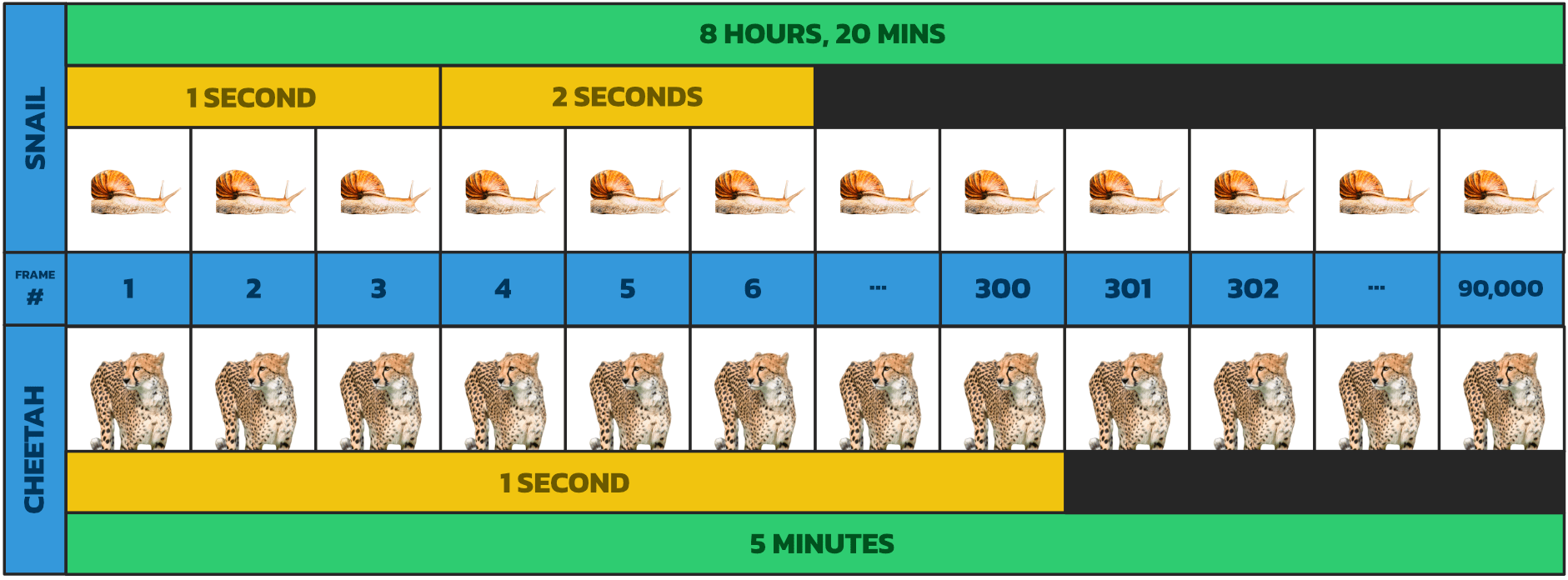
The cheetah is observing the game at 300 fps, so during the 5-minute period she experiences 90,000 game loops (300 fps x 60 seconds x 5 minutes = 90,000). Yet, if you divide 90,000 frames by the snail's low 3 fps frame rate, 8 hours and 20 minutes have gone by for the snail.
Here's a video of me demoing special relativity in Minecraft...
The field of physics has been stuck for half a century because Einstein's theory of relativity makes accurate predictions, but is fundamentally incompatible with another accurate theory: quantum mechanics. Physicists have been banging their heads against a wall — a wall that they assume is real.
And that's the problem, right there. It's why their unifying theories won't compile. Their logic is buggy, and the bug is deeply rooted in the operating system of the scientific establishment — Materialism.
Here's the specific bug, expressed in a syllogistic format...
Special relativity is a deductive argument resting on two postulates:
As soon as you invalidate one of Einstein's postulates, you invalidate the entire argument.
When Einstein asserts that the speed of light remains the same for all observers, he is assuming the fundamental existence of "speed." Speed is the distance traveled through space in a discrete period of time.
If space and time don't fundamentally exist, then neither does speed.
Using a deductive process from first principles, we know that space and time don't fundamentally exist in a non-dual universe. Therefore, Einstein's second premise is false, which renders his argument unsound.
Hence, using deduction, we know that Einstein is right at a superficial level and wrong at a fundamental level.
It's like he's right at the level of truth that we observe in the game, but wrong at the deeper level of truth that constructs the emergent illusion of the game (i.e. the lower-dimensional codebase).
I know it's kinda arrogant for a non-physicist to debug Einstein's work, but this is just where the logic leads, so...

Now I'll continue deconstructing the illusion of time.
Let's say we have two dots: a red dot and a blue dot. To create the smooth illusion of space, each dot can only move one pixel per game loop relative to its previous location.
Let's make the dots race each other in the game.
This is how the red dot moves during the race...
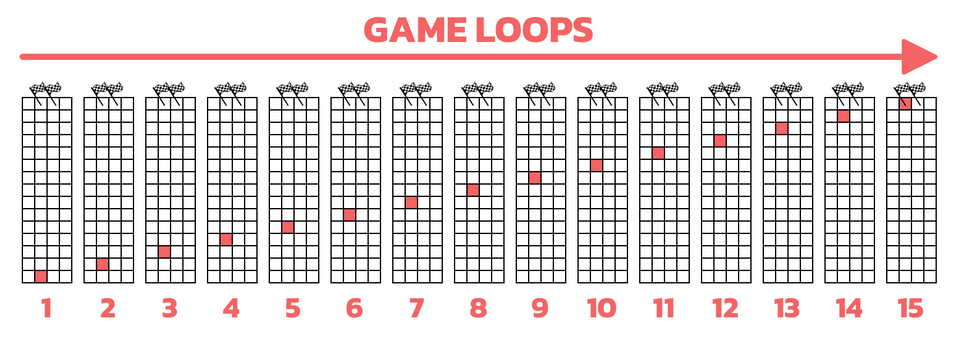
The red dot moves one pixel per game loop.
This is how the blue dot moves during the race...
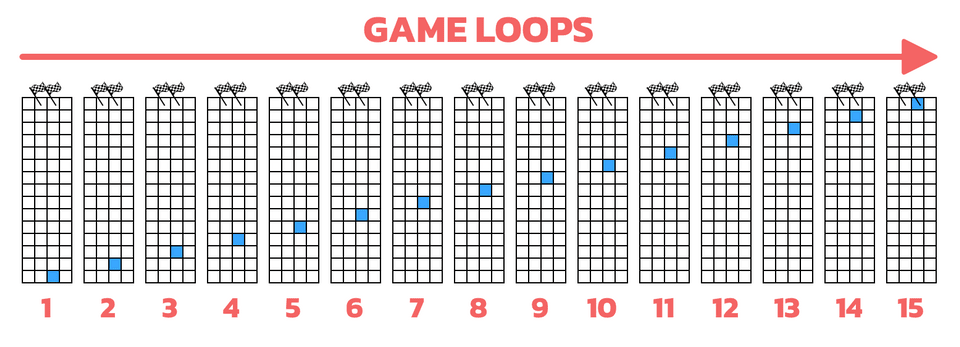
The blue dot also moves one pixel per game loop.
Time doesn't exist in our model yet. To create time, we have to count the movements of each dot relative to each other.
Let's say you're the red dot. Your frame rate is three times slower than the blue dot's. As you complete the race, you'll experience this...

You're the red dot. You're moving pixel by pixel through the race over 15 game loops. Every time you move a pixel, the blue dot has moved 3 pixels.
But if you're the blue dot, your frame rate is three times faster than the red dot's. As you complete the race, you'll experience this...

You're the blue dot. You're moving pixel by pixel through the race over 15 game loops. Notice how you move through 3 pixels worth of "space" before the red dot moves 1 pixel forward.
But it's so impractical and confusing to constantly talk about movements as "me" relative to "you," "this" relative to "that."
Instead, we assign the symbol 1 second to represent the idea of a grey dot moving through 15 pixels of space.

We use the symbol 1 second to refer to the grey dot moving through 15 pixels of space. Notice that 1 second is not referring to a thing called "time". It's referring to a movement through space.
Now we can casually say, "The blue dot took 2 seconds to complete the race, and the red dot took 6 seconds."
But what we're really saying is, "It took twice as long for the blue dot to complete the race, relative to the grey dot. And it took the red dot six times longer to complete the race, relative to the grey dot."
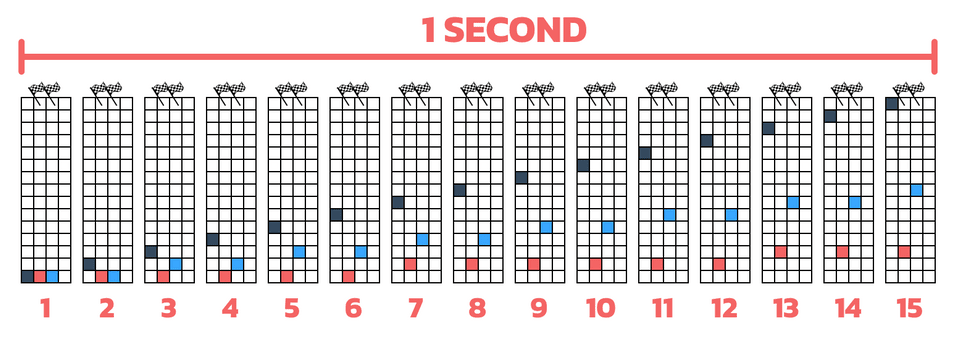
The grey dot moves through 1 second of space. Then we measure the movements of the red and blue dots relative to the grey dot.
From this, we can clearly see that time is not a "thing" that passes. It's just our way of counting movements through the relative information structure we call "space".
But humans don't notice this. Our rational minds believe space and time are physical features of the universe when they're actually illusive constructs — just like money. We use dollars to trade value. We use seconds to trade time. We use meters to trade space. But what's a dollar? And what's a second? And what's a meter? They're fairy dust. They don't exist.
I hope, by now, I've thoroughly dismantled the concept of "space" and "time" in your mind.
This step was crucial. If you want to master reality-creation, you have to get over the idea that space and time are immutable, physical features of the universe. They're not. All that exists is information relative to other information — just like a computer game.
In this computer game, space and time are emergent illusions. Individual pixels are just colored squares. But if you zoom out and view the pattern as a whole, you can clearly see a man walking into a room full of soldiers.
Space and time emerge when your perspective shifts through the information structure. As you learn to manipulate your perspective, you can manipulate the information structure.


I sat cross-legged on the floor of my primary school classroom, sketching a dragon inside my exercise book. She was ferocious, with gnarly teeth and fierce eyes, and expansive wings that spread across two pages. She floated there, staring down a courageous man with mighty muscles. He hoisted his sword in the air as his Friesian horse reared and roared in defiant retaliation.
Gameism is an indie project by Nikki Durkin

